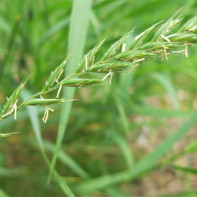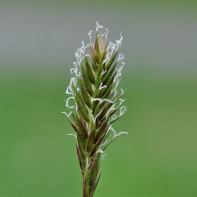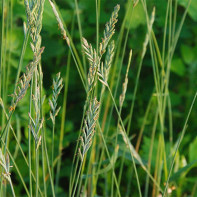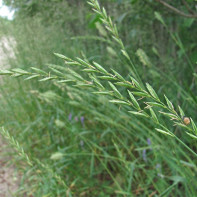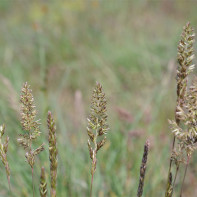Wheat grass: medicinal properties and contraindications
What people have not invented names for wheatgrass! One worse than another: they call it dog grass and rye. In some areas it is called "waders", in others "dandura", in others - and even "worm-grass". If a dacha developer or a gardener dreams that wheatgrass grew luxuriantly in his favorite seedbeds or flower beds, he will wake up with palpitations. And realizing that it was just a dream, he will sigh with relief. Because couch grass is the headache of all lovers of digging in the ground. Its rhizomes quickly grow wide and deep, and it is difficult for the gardener to cope with it.
- Chemical composition
- How it looks and where it grows
- Types of
- Harvesting and storage
- Therapeutic properties of wheatgrass
- For Women
- For Men
- Couch grass in traditional medicine
- Kinds of medicinal compositions
- Infusion
- Tincture
- Decoction
- Tea
- Juice
- Culinary Applications
- Salad with wheatgrass
- Nettle mashed potato with onions
- Nutcakes with wheat grass
- Porridge with wheat grass
- How to get rid of wheat grass in the garden
- Contraindications for use
Chemical composition
Meanwhile, these very rhizomes contain many useful substances for humans. For example, wheatgrass is rich in vitamins C and E - ascorbic acid and tocopherol, which have the ability to slow aging and strengthen the immune system. The complex polysaccharide starch also works to strengthen the immune system; it is also necessary for the brain and muscles. The power of carotene in the rhizome is in its ability to remove free radicals from cells and reduce the negative effects of adverse environmental conditions.
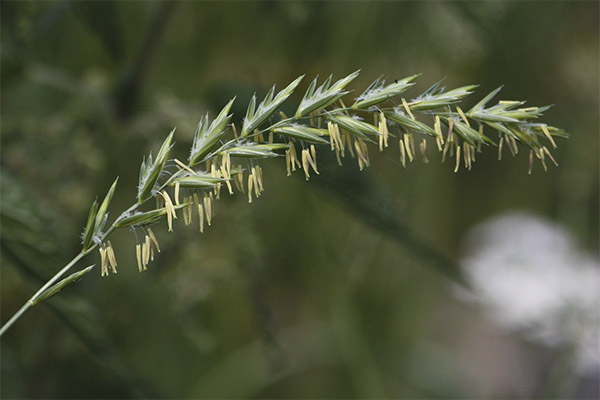
Among the components of wheatgrass rhizome, almost 10% is protein, and this is one of the most important "building materials" for the human body. The role of tricin (a carbohydrate which makes up almost 40% of wheatgrass) and fructose monosaccharide is to ensure rapid recovery.
A whole set of organic acids helps maintain the body's normal acid-base balance and participates in metabolic processes.
Mineral salts contained in wheatgrass are trusted by the human body to ensure the functioning of the cardiovascular, endocrine, nervous system and digestive tract; they are also responsible for balancing the water-salt metabolism and taking part in the process of hematopoiesis. The salts of silicic acid play a particularly important role, since with a lack of silicon it becomes difficult for the body to assimilate more than seven dozen chemical elements.
The oils responsible for the condition of skin, hair and nails are oily and essential oils, which are also included in the list of useful substances in the composition of wheatgrass.
The amino acid alanine is a constant active participant in all metabolic processes, providing endurance and positively influencing the work of the brain and muscular system.
What does it look like and where does it grow?
Wheatgrass belongs to the cereal crop. Its long, strongly branched root with a huge number of offshoots can penetrate deep into soft, loose soil - up to 1 m or more. But usually all its offshoots spread out to a depth of not more than 15 cm. But in width, the shoots from the root occupy a minimum "spot" of 3 by 3 m, and can extend over an even larger area.
Couch grass grows from 50 cm to 120 cm in height and is mostly pure green in color, but there are some species with a bluish-green above-ground part. The plant is usually smooth and bare, but there are also hairy specimens.
The leaves of wheatgrass have a flat shape, they are strongly elongated in length. Botanists refer to this form as the linear type. They can reach 40 cm in length and 10 cm in width (under favorable growing conditions). Fine veins can be seen along the entire leaf.
The tall stems end at the top in spikelets, which may vary in length from 10 to 15 cm. They contain 4 to 7 flowers with scales of an elongated, lanceolate shape. Couch grass begins to flower as early as the first month of summer, and seeds begin to ripen from the end of July.
This weed can propagate by rhizomes (this method is called vegetative) and seeds (another name is sexual). The plant is very adapted to both methods. Rhizomes can occupy huge areas, and in good soil they can give life to a huge number of sprouts. For example, one hectare of land overgrown with wheatgrass contains an incredible number of rhizomatous buds - about 250 million! And each of them can give life to a new plant. Even if a root is chopped into many pieces, not one will die aimlessly and a new weed will definitely grow from it. And even if one year the little stump lies quietly in the ground, showing no signs of life, the next year or even in a year or two, a new sprout may well develop from it.
Pollination of wheatgrass occurs crosswise, meaning that pollen from one plant is transferred to the pistil of the other. This creates a plant with a new genotype, which is even more resistant and hardy. The seeds, like root fragments, can survive unfavorable conditions in the soil for more than one season and make themselves felt even after 10-12 years. And since one plant can produce about 10,000 seeds, it is easy to imagine what a huge army each wheatgrass plant plants every year on the expanses of the fields.
The drought, which wheatgrass does not tolerate well, it survives in a sleeping state, but when the rains begin, it starts to grow vigorously and adds centimeters right in front of its eyes.
It has a home practically everywhere on our planet. Its main colonies are in the Northern Hemisphere, in European countries, in Asia, it survives in the North African heat and in the Southern Hemisphere. In Russia it is found all around.
A temperate climate suits it best. It likes fertile, sufficiently loose, nitrogen-rich soils, grows best on sand, but does not suffer much in swampy soils either. Its tall thickets are found not only in fields, but also on the banks of reservoirs, forest glades, along roadsides, along roadsides, and in steppes. As an uninvited guest, wheatgrass breaks into dachas and vegetable gardens, because it especially likes it where there is regular irrigation. But if the soil is not tilled for a long time and becomes dense, hard, as if nailed, it loses its activity, which resumes after the first plowing.
Couch grass littered fields dramatically lose yields, as it harms both the cultivated plants and the soil, which is deprived of nutrients and moisture. As a result, the land dries out and becomes dramatically impoverished.
Types
In nature, there are almost 30 species of wheatgrass. They differ from each other in height and structure of the spike, and this difference is explained by the conditions in which they grow.
For example, creeping wheatgrass, which is good everywhere, in any natural zone - even in a meadow or glade, even on the bank of a body of water, even in a vegetable garden or field, even on the roadside, grows tall - from half a meter to 1 m 20 cm. Accordingly, its stems and leaf plates are quite large and long. It is very difficult to eradicate.
And its relative couch grass is quite low-growing. It does not grow higher than 30-75 cm. Its habitat is the steppe, it is widespread mainly in southern regions of Russia and Ukraine. It likes sandy or limestone soils and settles on very dry meadows. It also differs from couch grass in color: its aboveground part is glaucous-green.
Another couch-grass - intermediate couch - also not very tall, growing from 40 to 100 cm. You won't find it in the middle belt of Russia, but it is widespread in the south: on steppes and in the dry lands of the Mediterranean and Central Europe. The Caucasus, Asia and the very south of Russia are also usual places for it.
Another southern wheatgrass is elongate. It may grow up to 1.5 m, though its average size is from 40 to 100 cm. Its element is salt marshes, chalky and limestone soils, roadsides of Asia, the Caucasus, the Mediterranean, the south of Russia.
Collection and storage
Despite the differences in the species of wheatgrass, they are all suitable for medicinal use. Folk healers know that it is best to dig up the rhizomes either in spring or in autumn. It is easiest to use dug up weeds in the garden. Their rhizomes should be a good shake off the soil, wash first in a bowl or bucket to make it easier to scrub them from the grains of sand, and then rinse with water directly from the faucet.
To help the roots dry out, you can start by putting them in a sunny spot, preferably when it's windy outside. Then put them in a shaded area, preferably on a veranda or patio. It is important that there is a draught and the wind blows the medicinal raw material. You can finish drying it with a dryer. Then the roots have to be cut up a little beforehand, so that it was easier to put in trays.
Keep dried rhizomes can be stored for a maximum of 2 years. In this case it is necessary to follow the rules of storage - put them in plywood boxes or in canvas bags.
Therapeutic properties of wheatgrass
This harmful and aggressive wheatgrass can serve a good service to man. Its medicinal properties have been known to healers for a long time. They have been used since the times of ancient Greece. Even the great Avicenna knew about the benefits of applying wheatgrass to wounds and about the ability of its root to have a healing effect.
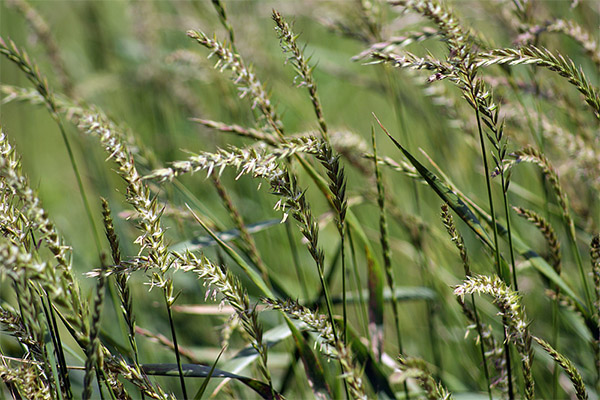
In pre-revolutionary Russia, wheatgrass was harvested for use in pharmacies. Today in European countries it is used in official medicine - in Germany, for example, where the use of wheatgrass is treated even at the level of the state health service. There it is used in cases of inflammation of the urinary tract and in the treatment of colds and acute respiratory infections.
Scientific medicine points to the ability of the rhizomes of the weed to regulate salt metabolism. It is also valued for its diuretic, diaphoretic and enveloping effects and expectorant action.
Wheatgrass is one of the remedies capable of restoring strength, increasing body tone, improving appetite and restoring sleep. The sugars and vitamins it contains contribute to this. It is also used for its ability to regulate blood clotting, to oxygenate and purify the blood. Thanks to the action of a plant increases the outflow of water from the body, while cleansing the capillaries, excreted toxins, and this helps to reduce skin rashes.
Prischestv wheatgrass and antihelmintic effect, in nature it is used by cats and dogs, eating grass and thus purified from parasites.
For women
Women are interested in wheatgrass as a means to maintain the skin beauty, health and youthfulness, reducing the number of wrinkles by controlling the oxidative processes in the body. In addition, vitamin E (tocopherol) contained in the plant's rhizomes helps get rid of acne, acne, and accelerates the healing of irritations.
Also tocopherol helps restore regular menstrual cycle and by increasing libido improves fertility - the ability to give birth to healthy and strong children.
For men
Men, like women, vitamin E helps to restore childbearing function, provides a normal composition of the seminal fluid. Experts say that it is necessary for forty year old male representatives of the stronger sex to regain their former masculine strength and natural carnal desires. In addition, gently relieving inflammation, the plant has a beneficial effect on the prostate, easing the course of prostatitis.
Wheatgrass in folk medicine
Folk medicine uses wheatgrass to treat various body systems - from metabolic diseases, gout and rheumatism to digestive pathologies, the cardiovascular system, the urogenital system and cancer.
A cup of wheatgrass tea can help with fatigue and feelings of exhaustion. It has been found that wheatgrass is effective in eliminating the effects of radiation and is even prescribed as a supplementary remedy for radiation sickness.
Preparations made from the rhizome, along with juice from the leaves, are recommended for the treatment of bronchitis, pneumonia, and acute respiratory infections. Wheatgrass has also proven itself in the fight against furunculosis and acne. For these and other skin problems, including diathesis in babies, urticaria, eczema, course baths using wheatgrass remedies are indicated. Usually prescribe from 10 to 15 such procedures. They also help with hair loss and hemorrhoids. In the latter case, wheatgrass can also be used in the form of an enema.
Means based on wheatgrass are widely used to get rid of liver diseases, including such serious ones as hepatitis, cirrhosis, abnormalities of the fatty tissue of the organ. As part of herbal gatherings, this plant treats gallbladder and ducts, biliary stone disease. Its anti-inflammatory properties are used in folk medicine to relieve symptoms of gastritis, colitis, enteritis. Folk medicine knows how to treat wheatgrass for hypertension, anemia, rickets. Means on the basis of this weed are used as auxiliary in the complex treatment of malignant tumors.
Types of healing compositions
Folk healers use wheatgrass in the form of tea, juice, decoction, infusion, tincture and tablets. Liquids are taken both internally and externally - in the form of baths, compresses and lotions.
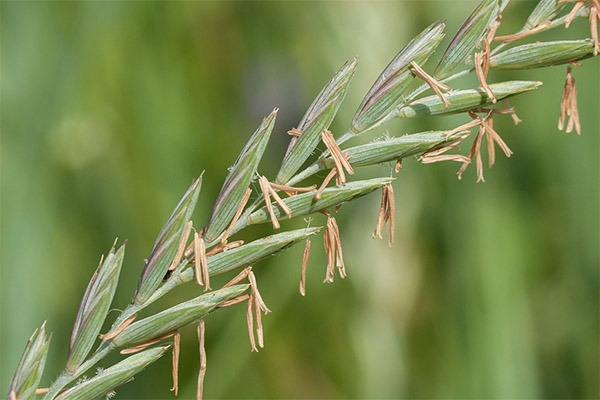
Tablets are taken only internally. Actually, they are not pills in the usual sense of the word. Folk healers prepare them from the juice of the above-ground part of the plant, for which they pass the leaves and stems through a meat grinder, or break them in a blender. From the resulting mass squeeze the juice, which is then impregnated with bread and roll it into small balls.
Taking these tablets for a month restores the body's immune system, improves health, and normalizes metabolism and the digestive system. The usual norm of such reception is once a day for an hour before meals.
Even folk medicine offers an original way to combat leg sweating with the help of live, freshly picked wheatgrass. In the evening, after feet are washed, barley straw and grass couch grass should be braided around fingers - just like woven baskets. Put socks on top of them and go to bed. In the morning, throw the grass and put on fresh socks. If you do so daily, will disappear excessive sweating, bad odor and associated diapers, abscesses.
Infusion .
- For gout and cystitis. To get a healing decoction, you need to crush dry rhizome. 2 large spoons of raw materials pour half a liter of boiling water. Close with a saucer or lid and insist 8 hours. Ready remedy to drink 20 minutes before breakfast, lunch and dinner, preheating until warm. Infusion effectively acts as a diuretic, expectorant and diaphoretic.
- For infertility. This remedy will be useful for both men and women. Dig up the rhizome, wash, grind (or use the finished dried raw material), brew 1 tablespoon with a glass of freshly boiled water. When it has stood for half an hour, you must strain and drink three times a day with a big spoon, without tying it to food intake.
- For cholecystitis. Pour 2 large spoonfuls of rhizomes in 1.5 cups of just boiling water. Insist for about 4-6 hours. Use after straining - a glass three times a day. Drink a course of one month.
Tincture .
- From a cough with a cold. Prepare 2 tablespoons of raw materials and 250 ml of water. It must be boiled and cooled to room temperature. Pour water over wheatgrass, insist 12 hours, then strain by squeezing the rhizome mass. Drink 3 times a day by the glass, you can not tie the reception of this drug to the intake of food.
- For gastritis. This tincture will help with colitis, enteritis and metabolic disorders. It requires a ready-made crushed rhizome. Pour it with cooled boiled water in this proportion: for 250 ml - 5 teaspoons of raw materials. Insist for 12 hours, then strain, separating the wheatgrass from the infusion, but the infusion does not pour out. Pour 250 ml of wheatgrass just boiling water and leave it in the heat for about 50-60 minutes. After straining both the first and second infusion should be mixed and drunk. The rate is 1/2 cup 4 times a day before meals.
- Alcoholic tincture. For a glass of good vodka have to squeeze 2 large spoonfuls of juice: pass in a blender fresh leaves and stems, and then squeeze through 4-6 layers of gauze. If you prepare this remedy in the summer, you can be treated for colds all winter, as wheatgrass in this form is stored for several months.
Decoction
- From hemorrhoids. The indications for this decoction are wider - including it is recommended for inflammatory processes in the large intestines, as well as exacerbation of inflammation of the bladder. To prepare a remedy 2 large spoonfuls of dry medicinal raw materials should be poured 1 cup of just boiling water and send to the stove for further boiling. Boil for 5-10 minutes. After cooling, strain and squeeze thoroughly. Decoction can be taken internally for 1/3 cup before meals three times a day. Can be used as a microclysm, which takes 2-3 large spoonfuls. If you intend to drink the broth, you can add a leaf of black currant for flavor during cooking.
- For diabetes. The remedy prepared according to this recipe, puts the metabolism in order. Pour 1.2 liters of water with a handful of roots of wheatgrass. Bring to a boil, then turn down the flame and simmer on the heat until the volume is reduced by about 25%. After straining, drink 1 tablespoon 4 to 5 times a day, regardless of meals.
- For Oncology. When deciding to use folk remedies, you should not forget that the main treatment is prescribed by the doctor, herbs can only be a supplement to the main course. It is necessary to take 2 tablespoons of dried remedy, pour them with two glasses of freshly boiled water and boil over low heat. The remedy should boil for about 15 minutes, no longer. After that, you need to cover the pot in which the herb was boiled with a lid and insist for about 3 hours. After straining, take half an hour before a meal. Daily rate - 3-4 times a day for 1/3 cup. The course lasts a month.
- Decoction on milk. For a glass of milk, take 1 tablespoon of rhizome. Bring milk to a boil, pour the medicinal raw materials and again put on the stove. It is necessary that the milk with wheatgrass boils for 10 minutes on a low flame. Cool to warm, strain and drink. Prepare the decoction twice a day. Helps women with inflammation in the ovaries and infertility resulting from this inflammation.
Tea
For juvenile acne.
For this problem, a tea of four herbs should be brewed. First, prepare an herbal collection: two parts of the rhizome of wheatgrass and one part each of tricolor violet, horsetail, nettle mixed in a dry container, such as a glass jar. Make a tea of 2 teaspoons of the herbal collection and a quarter of a liter of boiling water. After 10 minutes, strain like normal tea through a tea strainer and drink. The norm is 3 times a day. If you make such tea drinking a daily, traditional ritual, the skin will be cleansed very quickly.
Juice
Freshly squeezed juice of wheatgrass is good for relieving the symptoms of hemorrhoids. To get it, the above-ground part of the weed - both stems and leaves - should be washed and scalded with boiling water. Then twist in a meat grinder and add as much water as you get green herbal mush. Stir, squeeze with 4-6 layers of gauze and boil for 3 minutes. Drink 1/3 cup before each meal. Do not store the juice for more than two days, even in the refrigerator.
Cooking applications
People have adapted to use wheatgrass and in cooking. For the preparation of various dishes, both rhizomes and the above-ground part are used. The rhizomes are preferable: they are richer in useful components and at the same time juicy.
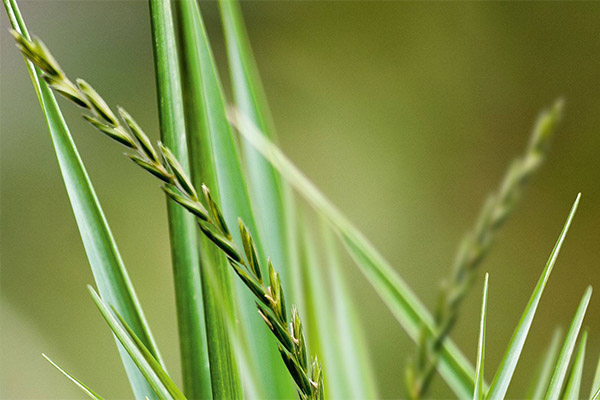
From the plant you can prepare full-fledged side dishes, they will perfectly complement both meat and fish products, suitable for dishes of mushrooms and vegetables. Those who like spicy and original food will especially like recipes with wheatgrass.
Salad with wheatgrass
In spring, this salad will be a real vitamin bomb, capable of awakening the body from its winter hibernation and moping. To make it, besides 100 g of roots of wheatgrass, you will need leaves of dandelion (about 40 g), nettle (about 50 g), as well as plantain and gout (30 g each). Supplement the herbal mixture with dill, parsley, green onion feathers. The rhizomes should be boiled a little beforehand (10-15 minutes). All the greens should be chopped, salted and dressed with sour cream or mayonnaise.
Purée of wheatgrass with onions
For this dish, which can be considered dietary, you need 300 grams of roots of wheatgrass. Wash it, boil it until soft, remove it from the pan with a slotted spoon and mince through a meat grinder along with 50 grams of onion. Season with salt and pepper and pour on sour cream.
Cakes with wheatgrass
Prepare dough on yeast, but replace part of wheat flour with wheat grass root flour, grind the dry root in a coffee grinder. And the flour is made only from young rhizomes, the old ones are not suitable for this purpose.
For one and a half kilograms of wheat flour take half a kilo of wheatgrass. And then do everything as usual: dissolve 1 teaspoon of salt in a glass of milk, 1 tablespoon of sugar, add a bag of dry yeast. Knead the dough until it stops sticking to your hands and starts to come off the walls of the bowl. Leave to rise.
Filling for such patties can be boiled and chopped eggs mixed with rice, mashed potatoes with fried onions, minced meat. These patties can be baked in an oven or fried in a pan with lots of vegetable oil.
Porridge with wheatgrass
To prepare this porridge, you need to crush the young rhizome of wheatgrass and turn it into groats. When boiling, mix this grits equally with any other, such as buckwheat or barley. Boil better on a water bath, at the end of cooking salt. Serve with milk or butter.
How to get rid of wheatgrass in the garden
It is possible, but not easy, to get rid of wheatgrass. Seasoned gardeners know that there's nothing like a good old spade or pitchfork. You just have to dig over and manually select the rhizomes, trying not to miss a single piece. It is long, difficult, and hard, but this way you can get rid of couch grass forever.
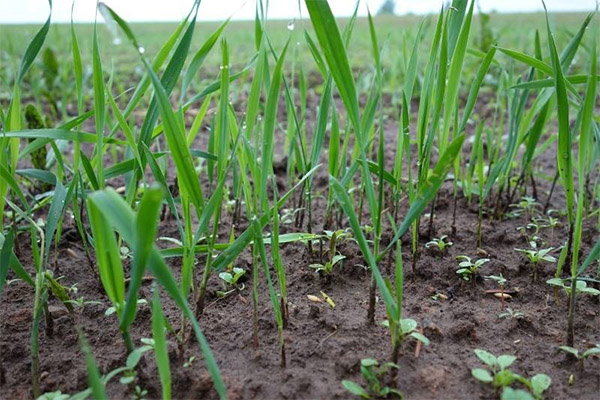
Couch grass is depressed by constant mowing and mulching of the soil. Mulching can be done either with black polyethylene film or a similarly colored covering material, or with the couch grass cuttings themselves. A dense layer of mulch prevents the weed from breaking through. But if this place is not mulched next year, it will still spring up.
If you plant siderats or so-called green fertilizers (e.g. mustard) immediately after the digging or plowing, they can also discourage couch grass from the plot and gradually "squeeze" it out of the garden. But it will not happen quickly, the couch grass must be sown regularly, over several years.
There are folk secrets, which are also used to fight wheatgrass. For example, often the territory of its spreading is watered with a strong solution of ordinary baking soda, when an ordinary pack of it is diluted in a five-liter bucket of water. But, of course, it is impossible to treat large areas in this way. Also watered with a saturated solution of salt, diluted in a bucket of water 3 kg.
It helps and 60% medical alcohol, which is watered in early spring, when wheatgrass just shows up from the ground. But this method is expensive, so it is not suitable for everyone.
Dacha owners also experiment with citric acid powder. If you make a strong solution of 3 tablespoons of acid diluted in a liter of water, and spray couch grass in good sunny weather, it will soon die.
Chemicals, namely herbicides, have about the same effect. These compositions are very effective: they penetrate the weed and kill it soon enough. But the rhizomes after citric acid and herbicides will still have to be removed by hand, by digging.
And yet experienced dacha owners are convinced that couch grass can be beaten by mowing, chemical treatments, and manual removal of rhizomes. The main thing is to use a comprehensive approach.
Contraindications to use
Wheatgrass - a rather harmless plant, and there are no special prohibitions on its use. Nevertheless, you should not get too carried away either by eating it, or by using preparations based on it. It is necessary to remember the main rule - "Do no harm", and it implies strict compliance with the prescribed doses or courses and adhering to the recommended timing of treatment.
Especially women during pregnancy and breastfeeding should not abuse formulas based on the plant. Do not rush to give infusions and infusions of wheatgrass young children under two years of age. But at the same time, therapeutic baths for diathesis are shown even to babies under one year old.
Those who have been diagnosed with severe kidney pathologies, peptic ulcer disease of the stomach, also do not recommend wheatgrass. It can provoke an exacerbation.
Individual intolerance to remedies and preparations that include wheatgrass is also possible. In such cases, it is better to abandon them altogether.
«Important: All information on the site is provided solely for introductory purposes. Before applying a particular recommendation or consult with the profile specialist before applying any recommendations. Neither the editors nor the authors shall be liable for any possible harm caused by materials."

